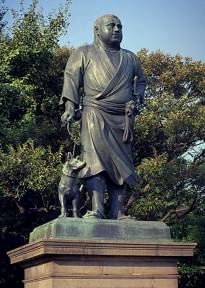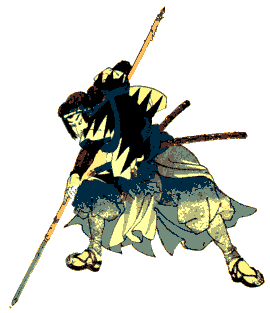The Collapse
of the Warrior Class
![]()
Feudal Japan had a rigid hierarchical class structure
intended to maintain stability in
the society. Society was divided into four classes- samurais, peasants, artisans
and merchants. The samurais who made up the military elite were at the top of the
social hierarchy. They rendered military and administrative services to the
Shogun and the daimyos (feudal lords). Interestingly, there were ranks within
the samurai class itself. Hence, a samurai could either be at the top, or
dwindling at the bottom of the class.
The
Declining Prestige of the Samurai Class
Prolonged
Period of Tokugawa Peace
The prolonged period of peace during the Tokugawa era
(1603-1750) after centuries of
warfare led to the displacement of the Samurai warriors. The Tokugawa Bakufu (government) aimed to ensure order and peace by maintaining a strong central
control. The Sankin Kotai system (alternate attendance) implemented required all
daimyos to spend several months at the Shogun courts (Edo) annually, leaving
their wives and children behind as hostages when they left. The trip not only
cost a lot in terms of time but
also money. The intention behind this policy was hence,
to reduce the capacity of the daimyos to rebel. Movement within the
country was also highly restricted with
numerous ‘check-points’ set up along main routes.
In addition to internal policies, the seclusion
foreign policy (sakoku) undertaken in 1639 also added to internal stability at
the expense on technological backwardness. The policy was partly a backlash
against the invasion of Christian missionaries during the “Christian
Century” which threatened a political system which relied on the unquestioning
loyalty of the people. It was also imposed because the Shogun felt increasingly
threatened as there had been news of some feudal lords purchasing firearms
from foreigners.
Effects on
the Samurais
This prolonged period of peace resulted in the lost
of martial capabilities among the samurais. Their role also became obsolete
since they could no longer fulfill their function as warriors which was to
fight. With no battles to fight, many became aimless and displaced. Their
prestige also suffered.
The Impoverishment of the Samurai Class
The slowdown in agriculture production after 1750 led
to the impoverishment of the ruling class and the rise of the merchant class.
Land which used to be the primary source of income for the ruling class had
ceased to be profitable. As a result, wealth
changed hands from the ruling class to the merchant class who were making great
profits from internal trade and organizing market transactions.
The lost of economic power compromised the position
of the ruling elite (Shogun/daimyos), who together with the samurais,
became heavily indebted to the merchants who lent them money. The
samurais became especially impoverished because they lived on a fixed income
which failed to sustain their luxurious lifestyle in a modernizing economy.
![]()
Faced with unemployed and displaced samurais, the
Shogun Ieyasu tried to help by emphasizing on the importance of learning. He
stated that “learning and military arts should be equally pursued.” As a
result, education became a means through which social mobility could be
achieved. Hence, many lower-class samurais from progressive domains such as Satsuma
and Chochu, were able to move up the administrative ladder. There was gradually
a growing disparity in power between the center and the periphery, as domain
governments became more efficient than the Bakufu.
In the early 19th Century, Japan faced
threat of foreign invasion as westerners sought to challenge the seclusion
policy. The defeat of China in the opium war, together with the superiority of western
military technology worked in advantage of the West. The
coming of Commodore Perry and his “4 black ships of evil mien” in 1853
effectively sealed the deal for the West. Perry had no trouble getting the
Shogun to accede to western demands. However, the incident was seen as a
violation of the sacred soil of Japan and the Shogun was blamed for his weakness
and inability to defend Japan from barbarians.
![]()
Rising Opposition to the Shogunate
Perry’s victory greatly shook the credibility of
the Shogun and the samurais played a significant part in organizing opposition
to the Shogunate.
The loyalist
movement: Shi Shi ( Men of High Purpose)
- samurais from the south-western domains whose
loyalty was to the daimyo and the emperor.
- aim to rid Japan of traitors who allowed barbarians
to roam the land
Sonno-joi
movement: (revere the emperor, expel the barbarians)
-initially aimed at the barbarians but as the bakufu
showed increasing inability to resist the West, the movement became hostile
towards the Shogunate.
On the 5th September 1864, the Choshu
samurai attempted to challenge the western naval power by shooting from behind
barricades. However, as the westerners advanced towards them, they simply fled
in fear leaving valuable armaments behind. This incident clearly reflects the
“decline of the samurai’s fighting spirit and lack of technical skill”.
Their inability to deal with the “possibility of man-to-man combat for which
their training should have prepared them for” was telling of their failure as
“warriors”.
Down Goes the Shogunate and the Warrior Class
The two movements mentioned above was not able to
bring the Tokugawa to an end. It was ultimately the movement led by the alliance
between the Samurai bureaucrats of Satsuma and Choshu, that brought down the
Shogunate. The samurais were united by their loyalty to the emperor, nationalism
in the face of foreign encroachment and their personal ambitions and
aspirations. Ironically, it was the success of this samurai campaign that
effectively paved the way for the elimination of the warrior class.
Elimination of the Samurai Class
The Meiji era (1868-1911) marked the beginnings of
modern Japan. The period was characterized by reforms driven by the desire to
make Japan an equal of the West, and emperor centered nationalism was the key to
its success. Modernization was directed against feudalism.
As a result feudal domains and the feudal classes were abolished.
The samurais had the most to lose. The constitutional
consequence was that “2000000 samurais no longer had a domain to and so had no
form of income”. They also lost all their special privileges. In 1876, Emperor
Meiji declared a new law which ended the wearing of swords. As a result, the
samurais lost their profession and right to wear swords. Their position as a
special class ended after almost 1,000 years.
An interesting phenomenon occurred with the abolition
of the samurai class. Many samurais who were greatly impoverished were forced to
sell their sword to raise money to feed their families.
An unthinkable act for a samurai. The money raised was known as “namida
no kane” (the money of tears). Some samurais went into other occupations.
Others who could not adapt simply continued to “dream of a more glorious
past”.
The
Last Samurai- Saigo Takamori

Saigo
Takamori (1827-1877) was the last known Samurai in the history of Japan. He was
an important and heroic military and political figure during the Meiji period.
Not only was he the leader of the military troops that overthrew the Tokugawa
rule, he was also the leader of the Meiji restoration.
Takamori
was a sacrificial warrior who was willing to die for his country as he regarded
that as the greatest honour. This was shown when he volunteered himself as an
envoy to Korea, with plans to provoke the Korean government into murdering the
envoy and thus give the Japanese government justification for declaring a war.
In doing so, he was risking his own life for the sake of extending Japanese
power to mainland Asia.
Unfortunately,
his plans failed and he went into exile on Satsuma, where he died in a later
rebellion against the government after being wounded and performing hara-kiri
(traditional Samurai ritual suicide).
